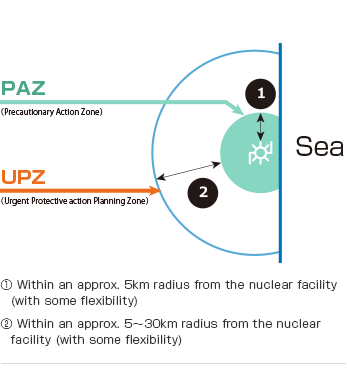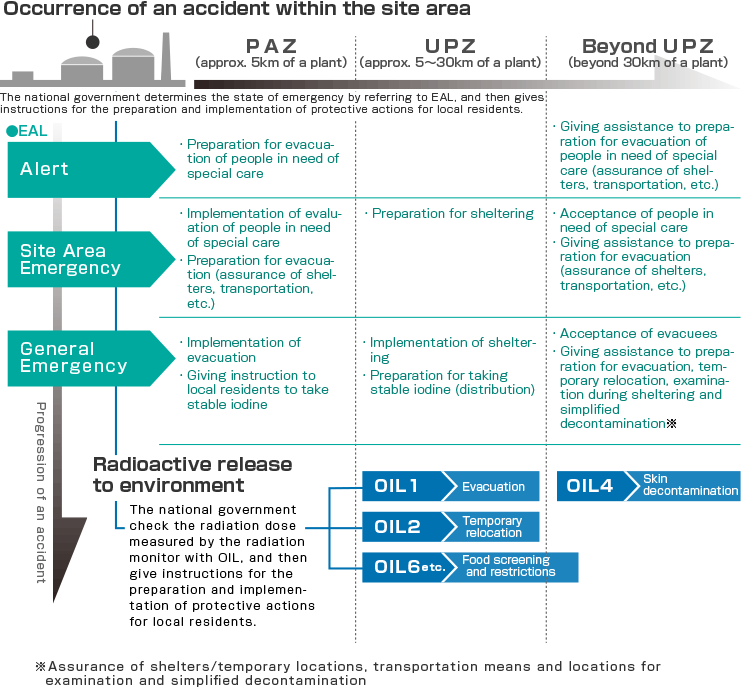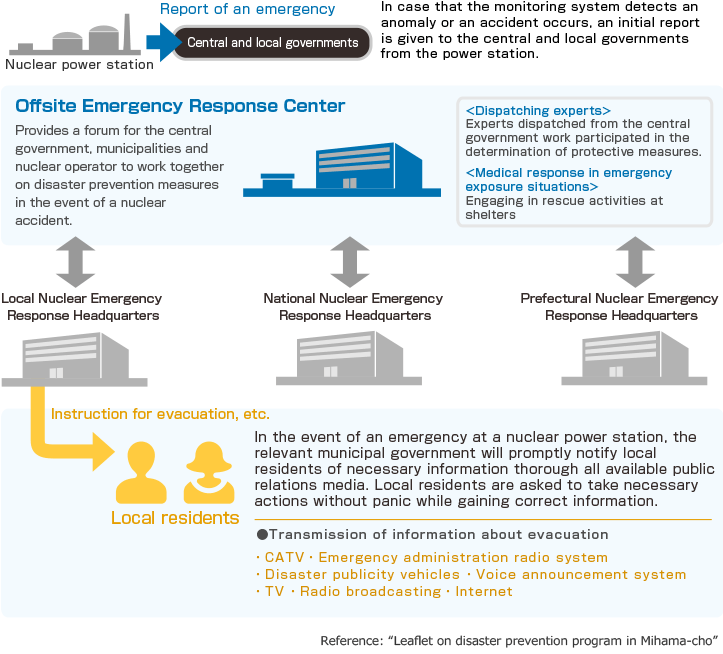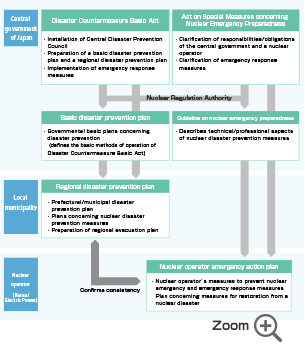Nuclear Power Information
Preparation for Potential Severe Accidents
 Nuclear Disaster Preparedness
Nuclear Disaster Preparedness
Our nuclear power stations are making an utmost effort to provide all possible safety measures. However, in case of a nuclear emergency, which is accompanied by an abnormal release of radioactive materials to the environment, we will take actions in coordination with the central and local governments in order to mitigate radiological effects on local people.
These emergency response activities shall be performed in accordance with the Disaster Countermeasure Basic Act and Act on Special Measures concerning Nuclear Emergency Preparedness. The central government of Japan, local municipalities and nuclear electric utilities are earnestly working on the nuclear safety/fire protection measures while enhancing their emergency response system respectively on a normal basis.
Priority Areas for Nuclear Disaster Prevention Measures
Priority areas, for which nuclear disaster prevention measures are proactively taken, are determined in advance so that protective measures can be taken in an efficient and timely manner to reduce radiological effects on the surrounding environment and radiation exposures received by local residents on an assumption of abnormal release of radioactive materials or radiation in case of an emergency.
Priority Areas for Nuclear Disaster Prevention Measures
- <PAZ(Precautionary Action Zone)>
An area for which precautionary actions are taken in advance within an approx. 5km radius from the nuclear facility - It is an area for which precautionary actions are taken in advance, including prompt evacuation prior to a release of radioactive materials, based on the Emergency Action Level (EAL), which provides the criteria for judging the severity of an emergency situation.
- <UPZ(Urgent Protective action Planning Zone)>
An area for which urgent protective actions are taken in advance within an approx. 30km from the nuclear facility - It is an area for which protective actions, including sheltering and stable iodine prophylaxis, are taken based on the Operational Intervention Level (OIL), which provides the criteria for judging the implementation of protective actions, and the Emergency Action Level (EAL), which provides the criteria for judging the severity of an emergency situation.

(Note) The actual boundary of the zones for which protective actions, including evacuation, sheltering and stable iodine prophylaxis, are implemented based on the EAL and OIL does not necessarily form a circle.
Reference: Guideline on Nuclear Emergency Prevention Measures (established by Nuclear Regulation Authority on October 31, 2012)
Municipalities located within a 30km radius from KEPCO's nuclear power stations
| Fukui prefecture | Kyoto prefecture | Shiga prefecture | Gifu prefecture | |
|---|---|---|---|---|
| Mihama Power Station | -Mihama-cho -Tsuruga city -Wakasa-cho -Minamiechizen-cho -Echizen-cho -Obama city -Echizen city |
-Takashima city -Nagahama city |
-Ibigawa-cho | |
| Takahama Power Station | -Takahama-cho -Ohi-cho -Obama city -Wakasa-cho |
-Maizuru city -Ayabe city -Nantan city -Kyotanba-cho -Miyazu city -Ine-cho -Fukuchiyama city |
-Takashima city | |
| Ohi Power Station | -Ohi-cho -Obama city -Takahama-cho -Wakasa-cho -Mihama-cho |
-Kyoto city -Maizuru city -Ayabe city -Nantan city -Kyotanba-cho |
-Takashima city |
Protective actions based on EAL and OIL
A basis for taking protective actions to reduce radiation exposure of local residents has been established in advance so that judgment and instructions for sheltering and evacuation can be made immediately in case of an accident at a nuclear power station.
Specific protective actions will be determined by the Nuclear Regulation Authority according to the situation of the accident and instructions will be given by the National Nuclear Emergency Response Headquarters.
| Emergency Action Level (EAL:Emergency Action Level) |
A criterion on which the preparation for or initiation of evacuation is determined as a precautionary action before a large release of radioactive materials occurs. The state of emergency at a nuclear power plant is divided into 3 classes and protective actions for local residents (i.e, sheltering and evacuation) are determined according to the class of the accident. |
|---|---|
| Operational Intervention Level (OIL:Operational Intervention Level) |
A criterion on which protective actions for local residents (i.e., sheltering, evacuation and temporary relocation) are determined based on the air radiation doses measured by the environmental monitor in case a release of radioactive materials occurs. |

| Emergency class and its criteria, EAL | |
|---|---|
| Alert |
|
| Site Area Emergency |
|
| General Emergency |
|
| Protective action and its criteria, OIL | ||
|---|---|---|
| OIL1 | Criteria for evacuation | Execute evacuation by designating the evacuation area within a few hours |
| OIL4 | Criteria for decontamination | Provide screening of evacuees and decontamination for those exceeding the criteria |
| OIL2 | Criteria for temporary relocation | Designate the evacuation area in about a day and perform temporary relocation within a week |
| Food and drink screening criteria | Criteria specific to the area measuring radionuclide concentrations of food and drink | Designate the area that measures radionuclide concentrations of food and drink within a few days Measure radionuclide concentrations in food and drink within a week and provide ingestion limits on those exceeding the criteria |
| OIL6 | Criteria for ingestion limits | |
* The definition of "5 minutes or longer" is applicable when the power supply system installed at the reactor facilities does not meet the provisions in Article 57-1 of "Rules on the criteria for the location, structure and equipment of the commercial power reactors and auxiliary facilities" and in Article 72-1 of "Rules on the technical basis for the commercial power reactors and auxiliary facilities".
Reference: Guideline on Nuclear Disaster Prevention
Communication in the Event of a Nuclear Accident
In the event of a nuclear accident,Kansai Electric Power(Nuclear operator) will immediately report it to the central and local governments. The representatives from the central government, relevant prefectures, municipalities and Kansai Electric Power will meet together at the Off-site Emergency Response Center and discuss to determine the protective measures according to the shared information and accident situations. The decisions made at the Off-site Emergency Response Center will be transmitted to local residents through the Nuclear Emergency Response Headquarters operated by individual municipalities.







